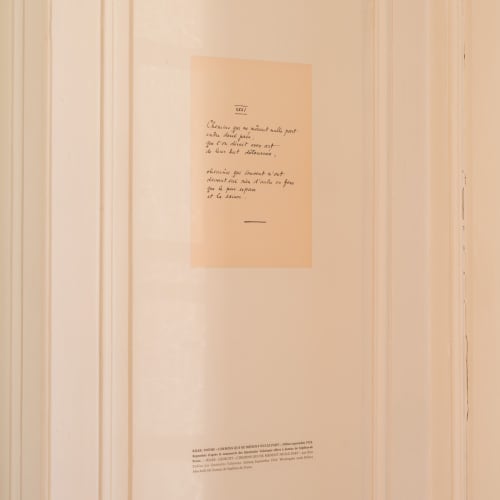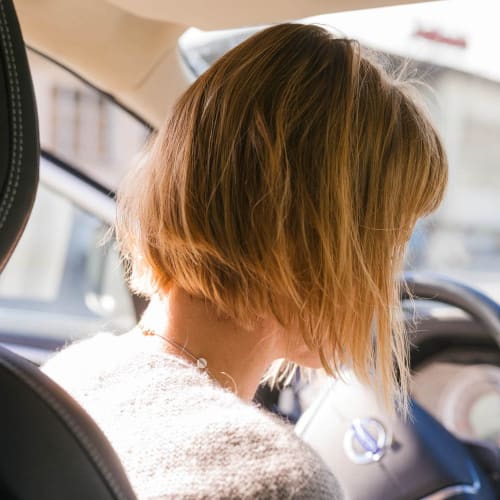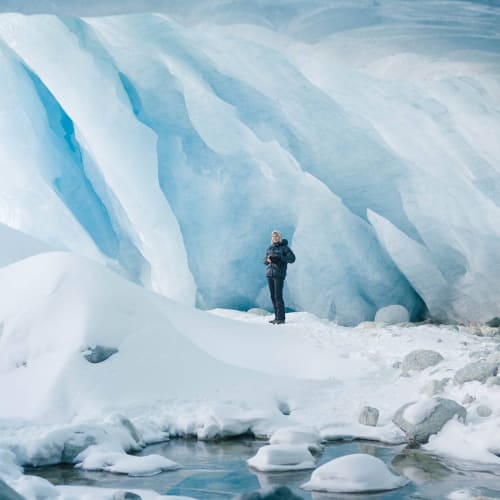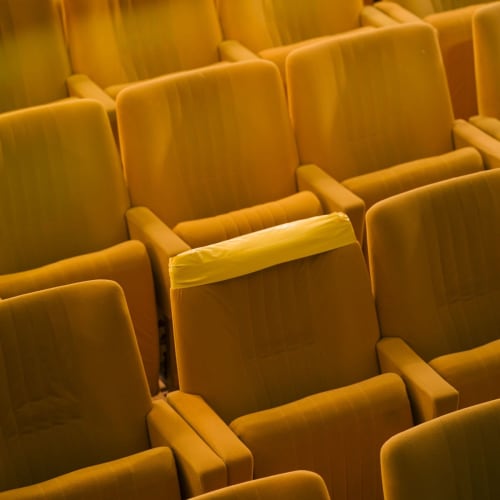THE FQM: During your time in the artist residency program, you only had a limited amount of time to experience and explore new places. Does this create any difference in terms of your creation process?
Su: Within the context of the artist-in-residency program, I think both my method and idea have to be more specific and clear.
THE FQM: During the three-month residency, was there any particular moment that enabled you to gain your own understanding of Valais? Or is it a process of accumulation?
Su: I feel like the impression of a place can be roughly formed at the very beginning when one first arrived there. And one’s understanding of a place gets gradually better as time goes on. Once, I was in a cable car going up the mountain. A passenger complained to her friend on the phone about it was snowing in May. As a short-term visitor, snow sounded exciting and expectant for me. The different perceptions brought by this sense of unfamiliarity could also be applied to other things in Valais.
THE FQM: Why did you abandon the grand proposition and decide to show more personal perspective and experience in your creation? In this series, what kind of clue is Rilke’s poetry?
Su: In the first week of arriving in Valais, I visited the cemetery of Rilke in St. Romanus Castle Church in Raron. The view (particularly the daylight and breeze) along the way reminded me of his discourse on poetry, (“poems are not feelings, they are experiences.”) As well as the invisible connection between one’s inner world and the outer world he mentioned in a letter to his friend. Those factors gave me the initial inspiration and laid some of the undertones of this project. I believe what is personal is also universal. Driven by these ideas, I am more interested in exploring a subjective sense of place with a personal approach.
THE FQM: This series of photographs is based on a personal perspective, so how are the characters of the creator reflected here?
Su: From my point of view, the characters of the creator are reflected in all the decisions he/she makes, specifically in the method and concept of the work.
THE FQM: In your works, the expression of poetics and the arousal to lyricism are very precise and deeply in touch. How is such precision presented?
Su: Poetic is often difficult to define and capture. If one is just looking for lyricism, it is easy to become over lyrical. Perhaps a neutral attitude is more important to me. What I’m interested in is to evoke a higher level of awareness by implanting a certain degree of concentration into the current situation, which then transforms into a photograph. Ideally, this awareness should be open and perceptible to the viewer, which could lead to a deeper understanding of the situation. This could be considered as some kind of “vaguely precise”.
THE FQM: What was your favorite meal you had in Valais?
Su: What I had the most in Valais were probably chicken breasts, broccoli, and the canned tuna from Italy. In retrospect, the sounds in the canyon are more impressive to me. I think sound reflects the structure of the place/space we are in. There are sounds of villages/cities, streets/squares, trains/cable cars, interiors, mountains, and nature.
THE FQM: For this project, what are your ideas about time and space? Compared to other media, what do you think are the limitations of photography?
Su: Photography is a spatial-temporal medium, or we can say that almost all artistic mediums are space and time related, because our perceptions of them are inseparable, but with different emphases.
Spatiality is the concept I focus on a lot in photography, or we can call it spatial relations, which involves different layers of translation. For instance, how three-dimensional reality (spatial things) transforms into a two-dimensional photograph (flat image). The structure of the image, the idea of framing and fragmentation, the relationships between parts and the whole, as well as absence and presence, are of interest to me. Furthermore, the consideration also incorporates the relationship between the photograph as an image (whether virtual or physical) and the space (electronic or architectural) where it exists. As for the concept of time, if we are willing to think deeper, there are actually multiple layers of time that exist within an image.
Take this picture for instance (Quatrains Valaisans, XXXI, R.M.R.), there could be four layers of time involved.
- The original time of the photographed subject. (this French poem was written by Rilke in the 1920s in Valais)
- The time when the photo was taken (spring 2016)
- The exposure time of the photo (shutter speed, about one or two seconds)
- The time when the viewer is looking at the photo (the present moment, i.e., now)
In this sense, a photograph is actually a synthesis of different layers of time. Let’s come back to the above question. The photo is a representation of the so-called “that-has-been” in spring 2016. That present soon becomes the past when we click the shutter. A connection can be established between the present we are in and the “present” in the photograph when we look at it. The displacement and gaps created by the overlapping of these different spaces and times are of interest to me. I think that is where the meaning or further understanding can be evoked.
Speaking of the relationship between photography as a two-dimensional image and other art mediums. Let’s take sculpture and installation for instance. They are viewed as three-dimensional objects, usually, they deal with spatiality more directly. They involve space/volume/size/materials, etc., which all affect the representation and our perception of the work. There is an intimate relationship between image and sculpture: sculpture/installation can be considered as spatial image, and image (painting/photograph, etc.) can also be considered as two-dimensional sculpture, which also needs to deal with spatial issues, including three-dimensional as well as two-dimensional spaces, and have similar considerations in terms of presentation. If we view moving-image as an extension of the photographic image, as a time-based medium, the spatiality does not seem to be considered in the first place. What I feel is more challenging maybe the architecture of time, which becomes the structure of the film/video itself. When it comes to limitations, we might say that photography is a relatively limited, restrained, or modest medium in its ability to represent time and space. And that it often does not require as much space and time for it to be presented (compare to sculpture/installation and film/video). However, Sometimes a massive sculptural installation is not necessarily more moving or powerful than a short poem on a piece of paper. This is not what people usually call less is more, rather, there is no single medium (languages/actions/other mediums) that can achieve full communication or transmission of our experience, then under these premises, all mediums are limited. So the question becomes how to fulfill our intention with the limited medium. This might be a common challenge to most practitioners.
THE FQM: Among your works, is the relationship between text and image complementary to each other? Or do they have other intentions?
Su: In general, the text is more diachronic, and the image is more spatial. But these characteristics in some cases convert, blur, and eliminate differences from each other. Text creates imagery and can become an image itself, and the still-image can transform into a time-based moving image as well.
In my film/video work, I am interested in the materiality of media, as well as the idea of intertextuality. For instance, how to combine different spatial and temporal characteristics of mediums to create multi-layer structures within audiovisual work. Eventually, a complex and organic narrative or representation can be generated in the work.
THE FQM: You said that what attracts you is the sense of place. So, what is it? How to build a sense of place?
Su: In my understanding, the sense of place is evoked by the atmosphere or situation resulted from human activities in the space (under the action of time). It can also refer to how we feel and experience a space. When we talk about feelings and experiences, they are subjective. For me, it is a process of translation, how to translate this subjective perception through the visual medium of photography, which is also like weaving many fractions (images) to form a larger collection. I would like to quote Godard’s words here[1] ‘Photography is not a reflection of the real; it is the reality of that reflection’. In this sense, it points more to the medium itself, as well as the artist’s methods and attitudes.
THE FQM: If you could travel back to Valais, do you have any missing parts of the creation process that you want to complete? If you had the opportunity to spend a day with Rilke in Valais, what would you want to do with him?
Su: If I could go back, maybe I would have a clearer idea, either to continue work on the project within the medium of photography or to take an interdisciplinary approach to produce a project that incorporates time-based media and spatial installation. If I had the chance to spend a day with Rilke, I would like to have a picnic, take a walk, or hike with him.
THE FQM: Have you seen any exhibitions or works that impressed you recently?
Su: There was an exhibition at ICA Boston which I like a lot: Ragnar Kjartansson: The Visitors.






